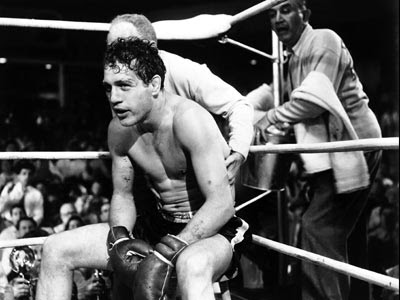
The Colour of Money
Dir. Martin Scorsese
(1986 Touchstone Pictures)
The sequel to Newman's Hustler, Fast Eddie is back. It's 1980's and Newman has given up the game – now a whiskey dealer or something, he meets a talented player Vincent Lauria and decides to take him on the road – teaching him the tricks of the trade. Watching Scorsese's film, it's opera, it's trash, it's a wonderful celebration of the power of cinema. I'm sure a line that is used far too often, but here all the elements are at work to show you how wonderful film can be. The opening credits follow a line of smoke as Scorsese breaks down the rules of nine ball pool. It's mesmerising and beautiful seeing the smoke dance – only on film can you observe such beauty. Michael Ballhaus' camera work is outstanding weaving through pools halls to the likes of Clapton and Palmer. There's a truly magical moment when Vincent and Fast Eddie enter a pool hall on the road at the beginning of their journey to Atlanta, Clapton's 'It's in the way that use it', crescendos as the camera glides through the hall, it brought a tear my eye – it was perfection – the kinetic energy and excitement I had watching the scene. When we get to the Atlanta the camera pulls the most impressive tilt from the ceiling down onto Newman – the choreography and ingenuity is incredible. The final scene as Newman and Cruise rack up, the lights around the bar, dim down, climaxing the film, the photography is as much a wonderful character as Fast Eddie in the film. And Schoonmaker doesn't do a bad job with the editing either, unsurprisingly there are wonderful pool montages.
Richard Price is a good writer see Clockers and The Wire if you don't believe me. Here in The Colour of Money it's fast talking throughout. The whole Vincent 'I'm a jealous guy with my girlfriend' doesn't work and the stand off's with Newman and Mary Elizabeth Mastrantonio don't sit well. But the reason is more to do with Cruise's performance, here - he's a kid, but not a hungry a kid, more a spoilt brat kid. His character transition arc whatever you want to call it, happens at a flick of switch, come the end he's suddenly turned into a hustler to rival Fast Eddie – it doesn't work and it's because of Cruise's acting – nothing else. Maybe Cruise's performance is made all the more weak when your in contention with Newman, Fast Eddie second time round is vintage, Newman is truly stellar in his put downs, his attire, his white Cadillac and pool play. Cruise aside enjoy Scorsese celebrating cinema; Newman reprising arguably his most loved role and Ballhaus' photgraphy, and rock n' roll.















